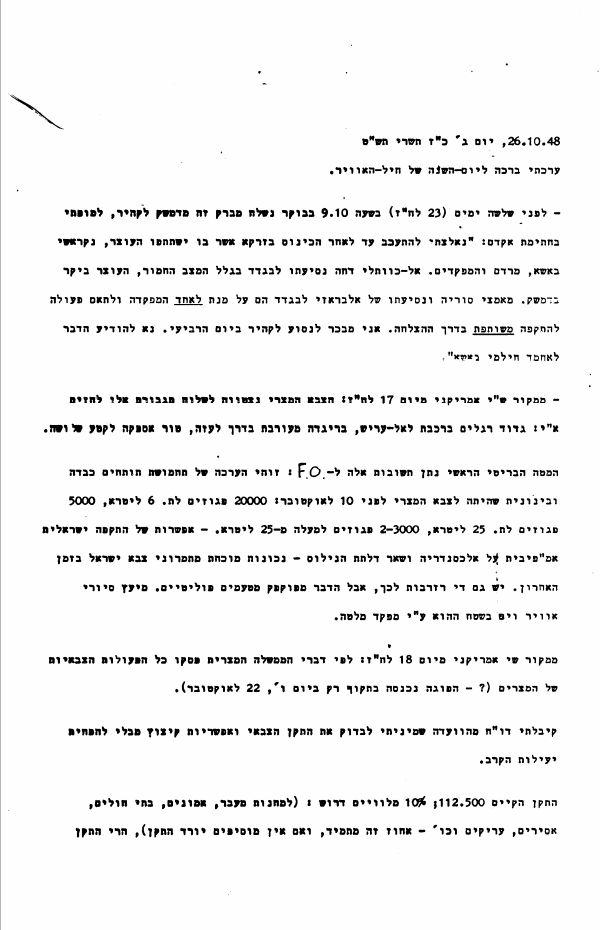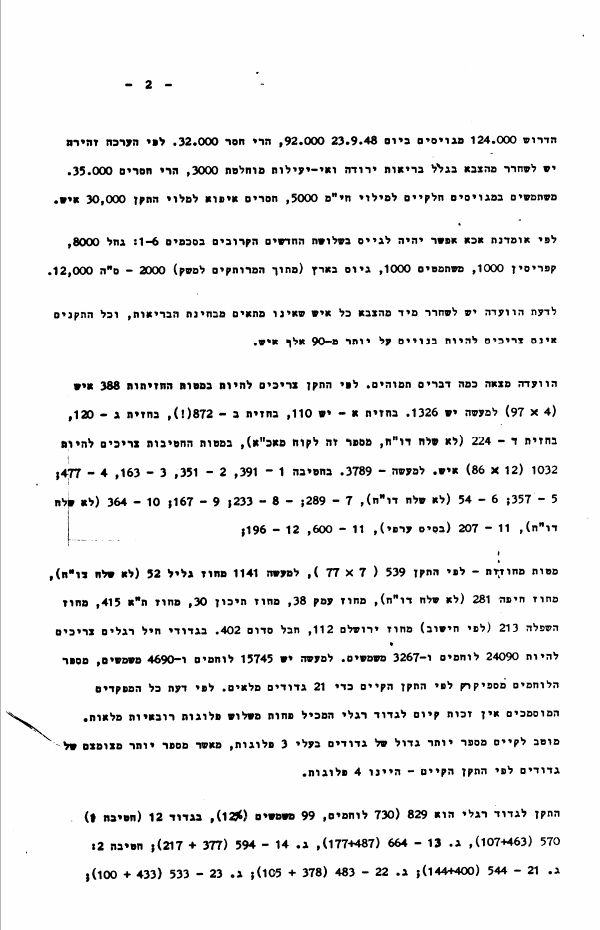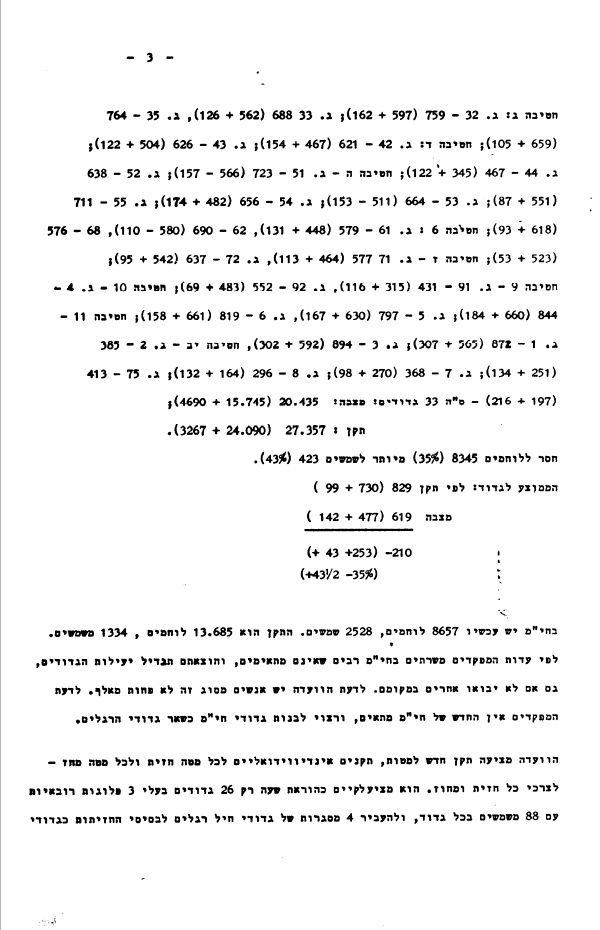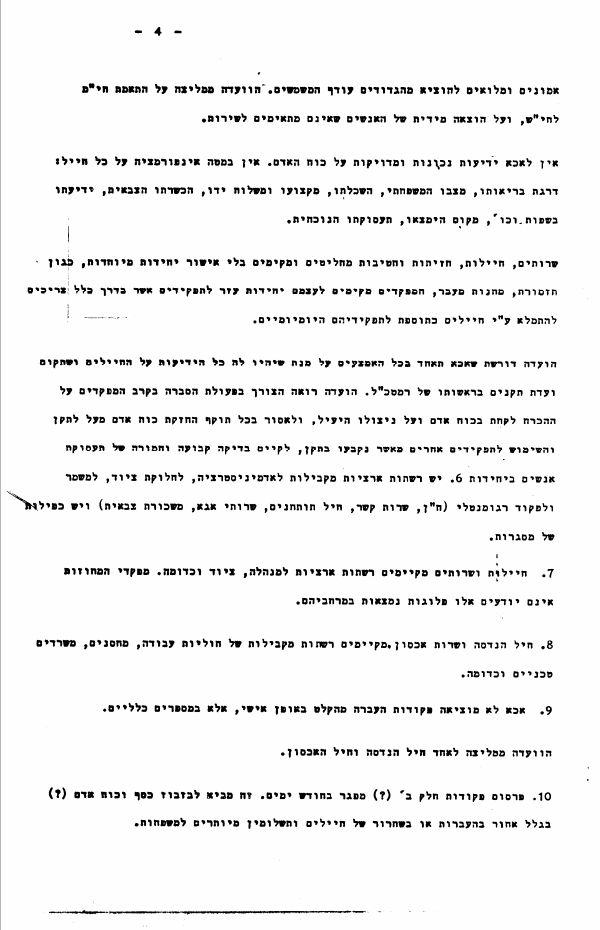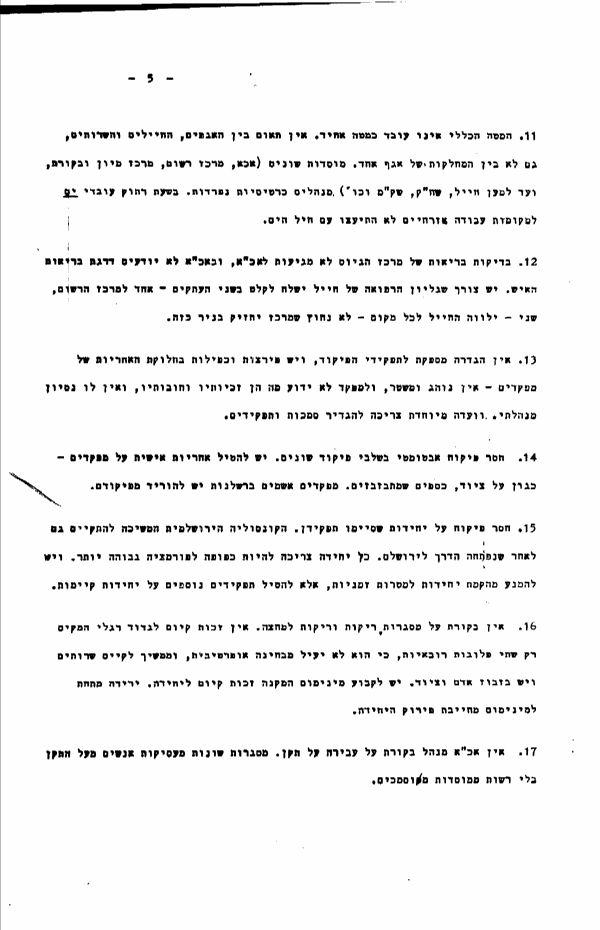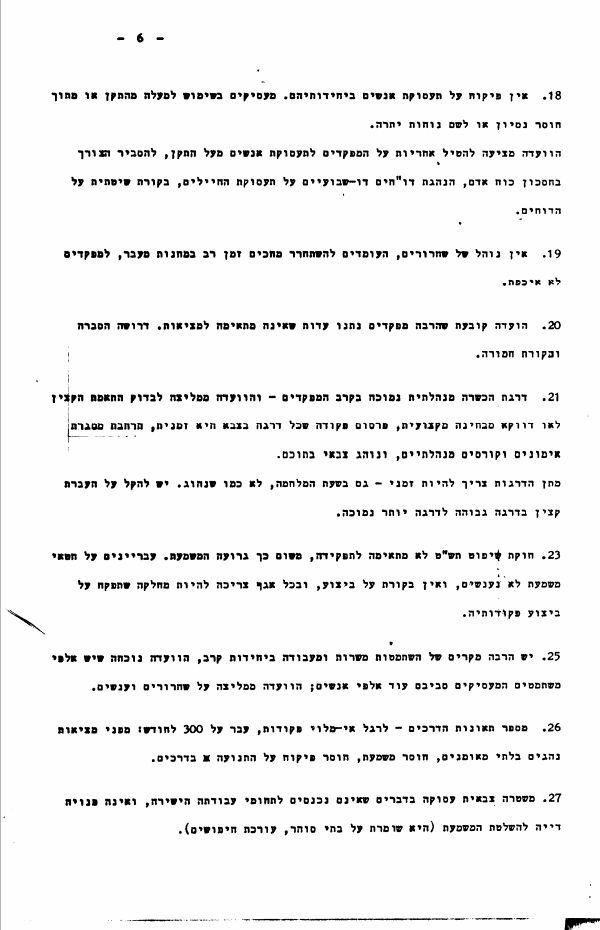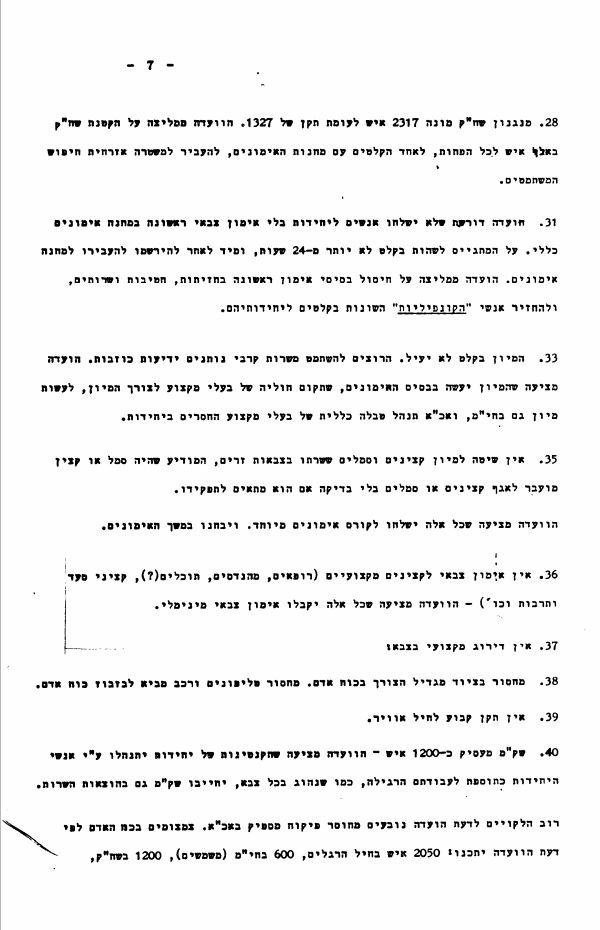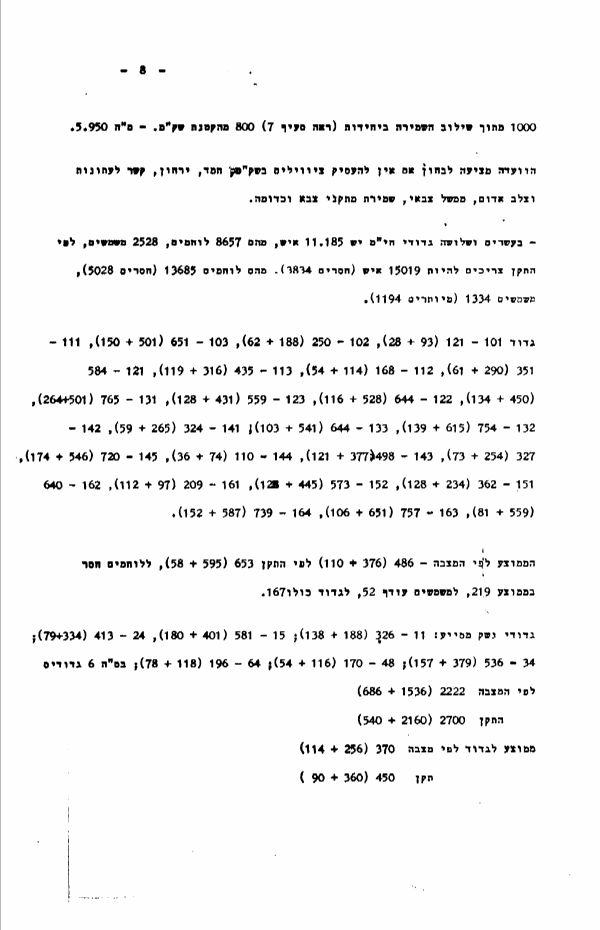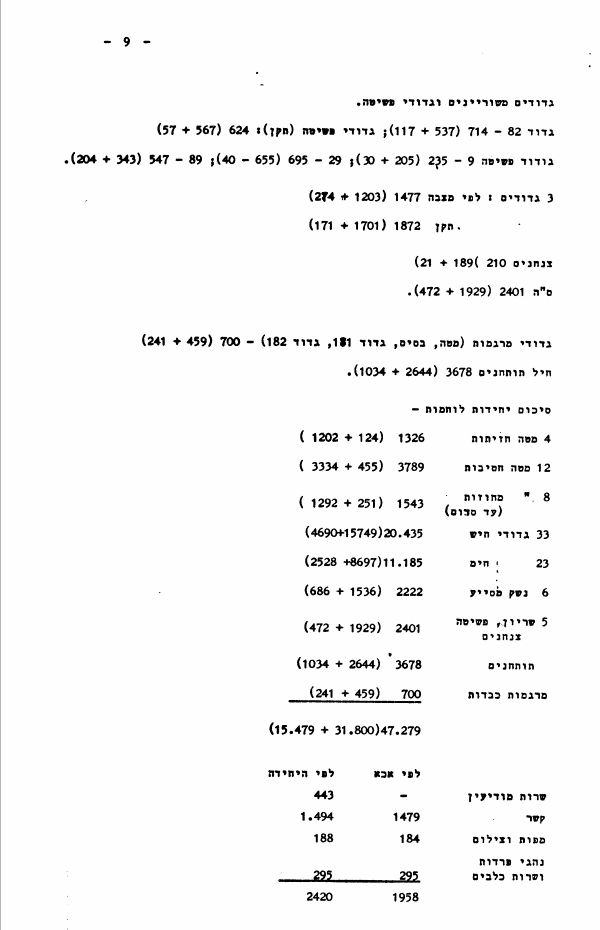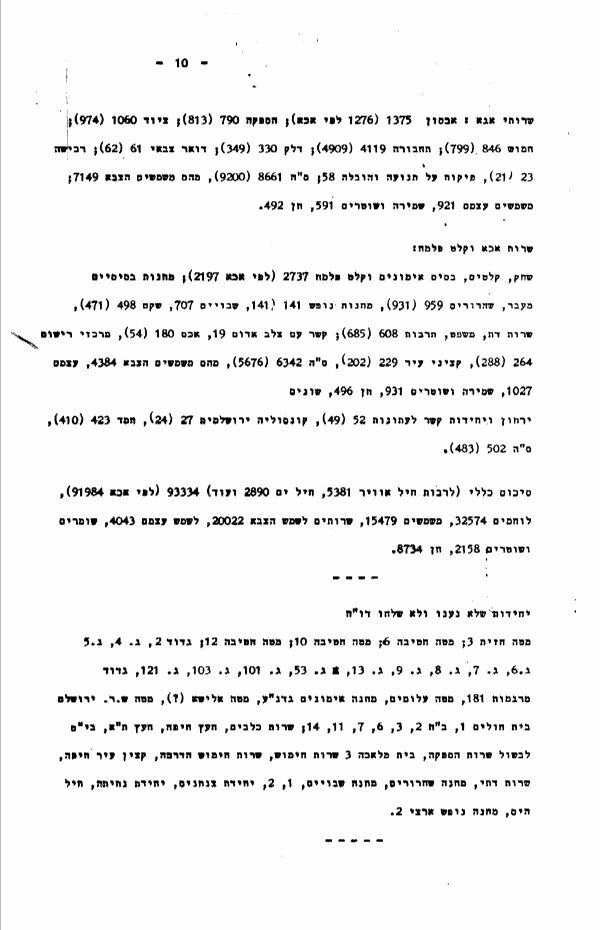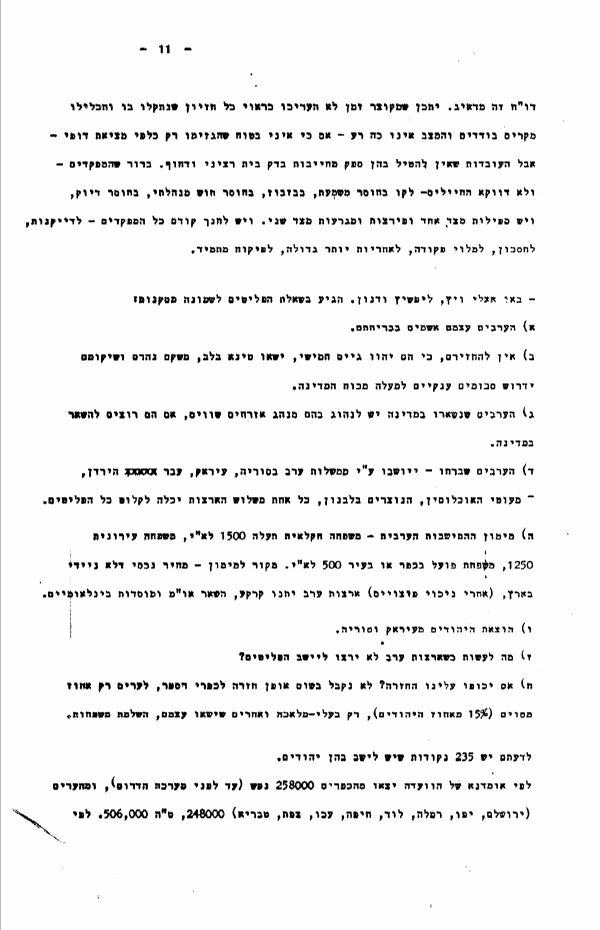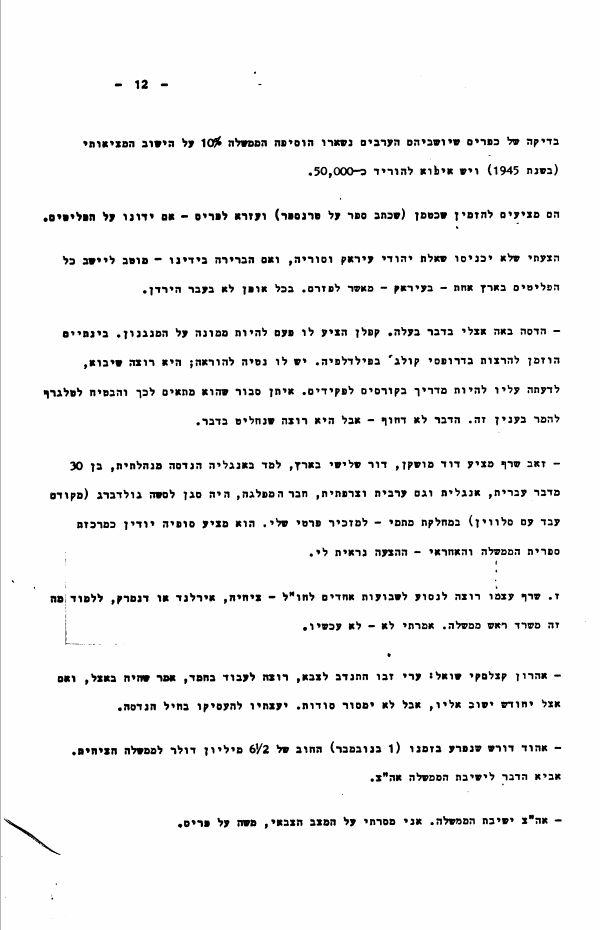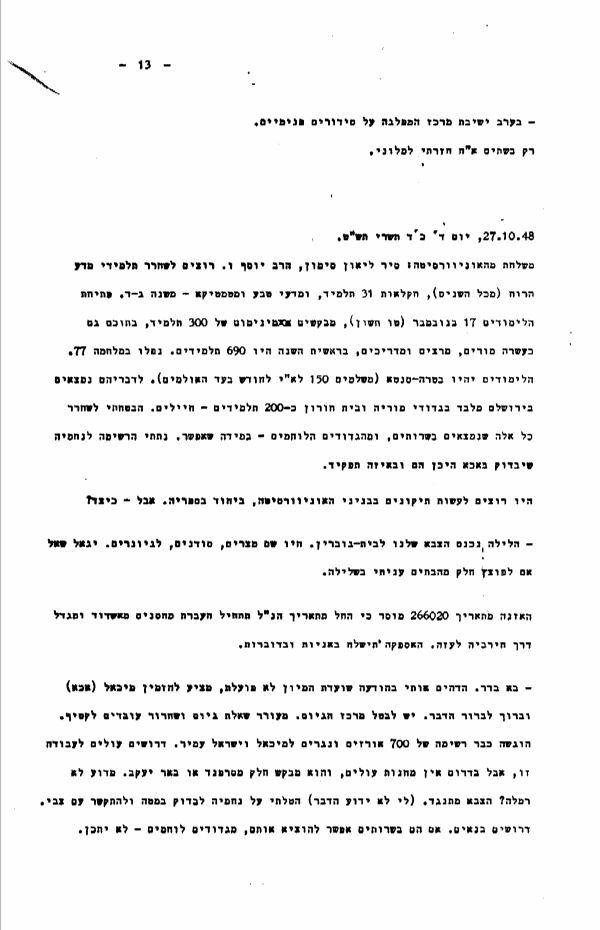1
of
Places:
Etan
Emunim
Baghdad
Barak
Damascus
Cairo
England
Ezer
Haifa
H̠emed
Sa'ad
Alumim
Jaffa
Lod
Ramla
Acre
Philadelphia
Paris
Safed
Dor
H̠ever
Sofia
Gaza
Alexandria
Egypt
Jerusalem
Tverya
Czechoslovakia
The use of the photograph is subject to the Copyright Law, 2007
25.10.1948
225112
Tuesday, October 26, 1948 I prepared commemoration remarks for the anniversary of the Air Force. – Three days ago (23rd of this month) at 9.10 a.m. the following cable was sent from Damascus to Cairo, to the Mufti signed by Iqdam [sp.]: “I was delayed until after the gathering in Zarqa, which will be attended by the [Iraqi] regent, [Egyptian Prime Minister] Nuqrashi Pasha, [Syrian Prime Minister] Jamil Mardam, and the commanders. [Syrian President Shukri] al-Quwatli postponed his trip to Baghdad because of the serious situation. The [Iraqi] regent visited Damascus. Syria’s efforts and the trip to Baghdad by [Dr. Muhsin] al-Barazi [a Syrian Minister and assistant to the president] are intended to unite the command and coordinate action for a successful joint attack. He prefers to travel to Cairo on Wednesday. Please let Ahmed Hilmi Pasha [president of the All-Palestine Government] know. – From an American intelligence source on October 17: The Egyptian army was ordered to send the following reinforcements to the Eretz Israel front: an infantry battalion by train to El-‘Arish, a mixed brigade via the road to Gaza, a supplies column to sector three. The central British headquarters submitted an assessment to the FO [Foreign Office]: In their view [these were] the quantities of heavy and medium cannon artillery held by the Egyptian army before October 10: 20,000 shells for 6-pound [anti-tank] C. [cannons], 5,000 shells for 25-pound [field] C., 2,000-3,000 shells of higher [caliber] than 25 pounds. There’s a possibility of an amphibious Israeli attack on Alexandria and the rest of the Nile Delta. Recent maneuvers by the Israeli army have demonstrated the capability. There are also enough reserves for this, but it’s questionable for political reasons. The advisor on air and sea reconnaissance in that area is with the Malta command [?]. From an American intelligence source on October 18: According to the Egyptian government, all of Egypt’s military activities have ceased (? – The truce entered into force only on Friday, October 22). – I received a report from the committee that I pointed to examine the military standard [i.e., service list, number of personnel] and the possibility of making cuts without reducing battle efficiency. The current standard is 112,500: [we] require 10% reservists (for transit camps, training, hospitals, prisoners, deserters, etc. – this percentage persists, and if not added, the standard decreases [i.e., manpower decreases]), so the required standard is 124,000. [The number of] conscripts as of September 23, 1948, [was] 92,000, a shortfall of 32,000. According to a cautious assessment, 3,000 need to be released from the army because of poor health and complete inefficacy, so the shortfall is 35,000. 5,000 partially mobilized conscripts are being used to fill garrison. So 30,000 men are missing to complete the standard. According to the Personnel Department assessment, over the next three months it will be possible to conscript [as follows for] skhamim [personnel classifications] 1-6: GAHAL [foreign recruitment] 8,000, Cyprus 1,000, deserters 1,000, in-country conscription (among those bound to the economy) 2,000 – total 12,000. In the committee’s view, anyone not suited in terms of health should be released from the army immediately, and all the standards should be based on no more than 90,000 personnel. The committee found a few puzzling things. According to the standard, the staffs of the fronts should have 388 men (97 x 4)[;] in fact there are 1,326. Front A – has 110, Front B – 872(!), Front C – 120, Front D – 224 (didn’t send a report, this number is taken from the Personnel Department), the brigade staffs should have 1,032 (86 x 12) men. In fact – 3,789. Brigade 1 – 391, 2 – 351, 3 – 163, 4 – 477; 5 – 357; 6 – 54 (didn’t send a report) 7 – 289; 8 – 233; 9 – 167; 10 – 364 (didn’t send a report), 11 – 207 (home front base), 11 – 600, 12 – 196. District staffs – according to the standard 539 (7 x 77), in fact 1,141[.] Galilee District 52 (didn’t send a report), Haifa District 281 (didn’t send a report), Valley District 38, Tichon [Central] District 30, Tel Aviv District 415, the Shfela [Central Plain] 213 (per calculation)[,] Jerusalem District 112, Sdom region 402. Infantry battalions should have 24,090 fighters and 3,267 service personnel [?]. In fact there are 15,745 fighters and 4,690 service personnel; under the present standard the number of fighters is only enough to fill 21 battalions. According to all the qualified commanders, there’s no justification for having an infantry battalion that includes fewer than three complete riflery companies. It’s better to have a larger number of battalions with 3 companies, than to have a smaller number of battalions per the current standard – that is, 4 companies. The standard for an infantry battalion is 829 (730 fighters, 99 service personnel (12%)[)], in Battalion 12 (1st Brigade) 570 (463 + 107), B. [Battalion] 13 – 664 (487 + 177), B. 14 – 594 (377 + 217); 2nd Brigade: B. 21 – 544 (400 + 144); B. 22 – 483 (378 + 105); B. 23 – 533 (433 + 100); Brigade Gimel [3rd Brigade]: B. 32 – 759 (597 + 162); B. 33 [–] 688 (562 + 126), B. 35 – 764 (659 + 105); Brigade Dalet [4th Brigade]: B. 42 – 621 (467 + 154); B. 43 – 626 (504 + 122); B. 44 – 467 (345 + 122); Brigade Heh [5th Brigade] – B. 51 – 723 (566 – 157); B. 52 – 638 (551 + 87); B. 53 – 664 (511 + 153); B. 54 – 656 (482 + 174); B. 55 – 711 (618 + 93); 6th Brigade: B. 61 – 579 (448 + 131), 62 – 690 (580 + 110), 68 – 576 (523 + 53); Brigade Zayin [7th Brigade] – B. 71 [–] 577 (464 + 113), B. 72 – 637 (542 + 95); 9th Brigade – B. 91 – 431 (315 + 116), B. 92 – 552 (483 + 69); 10th Brigade – B. 4 – 844 (660 + 184); B. 5 – 797 (630 +167), B. 6 – 819 (661 + 158); 11th Brigade – B. 1 – 872 (565 + 307); B. 3 – 894 (592 + 302), 12th Brigade – B. 2 – 385 (251 + 134); B. 7 – 368 (270 + 98); B. 8 – 296 (164 + 132); B. 75 – 413 (197 + 216) – in total 33 battalions: available manpower: 20,435 (15,745 + 4,690); standard: 27,357 (24,090 + 3,267). Shortfall in fighters 8,345 (35%), surplus service personnel [?] 423 (43%) average per battalion: per the standard 829 (730 + 99) available manpower 619 (477 + 142) -210 (+253 +43) (-35% +43½) In garrison there are currently 8,657 fighters, 2,528 service personnel [?]. The standard is 13,685 fighters, 1,334 service personnel [?]. According to the commanders, many of those serving in garrison are not suited, and removing them will increase the battalions’ efficacy even if they’re not replaced. In the committee’s view there are no fewer than a thousand men of this sort. In the commanders’ view, the renewal [?] of garrison is not appropriate, and garrison battalions should be constructed in the same way as the rest of the infantry battalions. The committee proposes a new standard for the staffs, individual standards for each front’s staff and for each district’s staff – and for the needs of each front and the district. It proposes, as a temporary order, only 26 battalions of 3 riflery companies with 88 service personnel [?] in each battalion, and to transfer 4 infrastructures of infantry battalions to the front bases, as training and reserve battalions, and to remove the surplus service personnel from the battalions. The committee recommends adapting garrison to Hayish [Field Corps], and immediately removing all men not suited for service. The Personnel Department does not have information about manpower. The Staff does not have information about each soldier: his state of health, his family status, his education, his profession and his occupation, his military training, his knowledge of languages etc., his location, his current employment. Services, corps, fronts, and brigades decide on and establish special units without authorization, such as an orchestra, transit camps; the commanders establish auxiliary units for themselves for roles that should usually be filled by soldiers in addition to their daily responsibilities. The committee demands that the Personnel Department consolidate all the resources so that it has all the information about the soldiers and that a standards committee be established headed by the chief of staff. The committee sees a need for hasbara [explanation, public relations] among commanders regarding the necessity of taking personnel and regarding its efficient exploitation, and [a need] for a firm prohibition against maintaining personnel beyond the standard and using them for purposes other than those established in the standard, [and there should be] regular and rigorous inspections of the employment of people in units 6. There are parallel nationwide networks for administration, equipment allocation, guard duty, and regimental command (WC [Women’s Corps], signal service, artillery corps, logistics services, military salaries), and there’s a redundancy of infrastructures. 7. Corps and services maintain nationwide networks for administration, equipment, and the like. The district commanders do not know which companies are stationed in their own sectors. 8. The Engineering Corps and housing service maintain parallel networks of work units, warehouses, technical offices, and the like. 9. The Personnel Department does not issue orders of transfer from intake on an individual basis, but rather in general numbers. The committee recommends merging the Engineering Corps and the Housing Corps. 10. The issuance of orders part 2 (?) lags by a month. This results in a waste of money and personnel (?) because of delays in transfers or the release of soldiers and unnecessary payments to families. 11. The General Staff does not operate like a unified staff. There’s no coordination among the departments, the corps, and the services, nor among the divisions within one department. Various entities (Personnel Department, registration center, processing and inspection center, the committee for the soldier, S.H.K. [military enlistment and integration service?], Shekem [food services], etc.) have different vouchers. When naval workers were confined to civilian workplaces they didn’t consult with the Navy. 12. The recruitment center’s health exams don’t reach the Personnel Department, and the Personnel Department doesn’t know the person’s state of health. Two copies of a soldier’s medical record should be sent to intake – one for the registration center, the second would follow the soldier everywhere – it’s not necessary that the center keep such a document. 13. There isn’t an adequate description of the command positions, and there are gaps and redundancies in allocation of commanders’ responsibilities – there’s no standard practice or system, and a commander doesn’t know his rights and duties, and doesn’t have administrative experience. A special committee should define authority and responsibilities. 14. There’s no automatic oversight at certain stages of command. Commanders should be assigned individual responsibility – such as over equipment, funds that are being wasted. Commanders who are guilty of negligence should be removed from their position. 15. There’s no oversight over units that have completed their role. The Jerusalem Consulate continued to exist even after the road to Jerusalem was opened. Every unit should be subordinate to a higher formation. And the creation of units for temporary purposes should be avoided; instead additional responsibilities should be assigned to existing units. 16. There’s no inspection of empty and partially empty infrastructures. There’s no justification for the existence of an infantry battalion that maintains only two riflery companies, because it’s not operationally efficient, and it continues to maintain services and there’s a waste of personnel and equipment. It’s necessary to establish a minimum that grants a unit the right to exist. Dropping below the minimum necessitates that the unit be disbanded. 17. The Personnel Department does not oversee violations of the standard. Various bodies make use of people beyond the standard without permission from authorized entities. 18. There’s no oversight over the way in which people are engaged in their units. They’re engaged in service beyond the standard or for lack of experience or for unnecessary convenience. The committee proposes assigning responsibility to the commanders for engaging people beyond the standard, explaining the need for conserving manpower, having biweekly reports on the engagement of soldiers, systematic review of the reports. 19. There’s no procedure for military discharge [or – release from service?]; those due to be discharged [released?] wait a long time in the transit camps; the commanders don’t care. 20. The committee found that many commanders presented testimony that did not accord with reality. Hasbara [explanation, public relations] and strict oversight are needed. 21. The level of administrative training among the commanders is low – and the committee recommends assessing the suitability of an officer not necessarily from a professional perspective, issuing an order that every rank in the army is temporary, [and] expanding the system of administrative training and courses, including military conduct. The issuance of ranks needs to be temporary – even during wartime, not as currently practiced. Reassigning an officer at a high rank to a lower rank needs to be made easier. 23. The [Jewish year] 5709 [1948-1949] judiciary law is not suited to its purpose, which is why discipline is terrible. Transgressors who violate discipline are not punished, and there’s no oversight over implementation, and each department should have a division that oversees the implementation of its orders. 25. There are many cases of desertion from service and from work in combat units; the committee is convinced that there are thousands of deserters who employ thousands more around them; the committee recommends releases [from military service] and punishments. 26. The number of road accidents – in light of failure to obey orders – has exceeded 300 per month: due to the reality of untrained drivers, lack of discipline, lack of oversight over traffic along the roads. 27. The military police is busy with matters that are not part of its direct purview, and is not sufficiently available to instill discipline (it watches over prisons, conducts searches). 28. The S.H.K. [military enlistment and integration service?] organizational staff numbers 2,317, in contrast to a standard of 1,327. The committee recommends reducing S.H.K. by 1,000 men at least, merging intake facilities with training camps, reassigning the search for deserters to civilian police. 31. The committee insists that men not be sent to units without preliminary military training in a general training camp. A conscript should not remain in intake for more than 24 hours, and immediately after registration should be transferred to a training camp. The committee recommends eliminating preliminary training bases at the fonts, brigades, and services, and returning the men from the various “confilias” [?] at intake facilities to their units. 33. The classification at intake is not effectual. Those who want to shirk combat service provide false information. The committee recommends that classification take place at the training camp, that a unit of professionals be established for the purpose of classification, conducting classification in garrison as well, and that the Personnel Department maintain a comprehensive ledger of the professionals lacking in the units. 35. There’s no system for classifying officers and sergeants who served in foreign armies; whoever reports that he was a sergeant or officer is transferred to an officers’ or sergeants’ department without any assessment of his suitability for the position. The committee recommends that all of these [individuals] be sent to a special training course. And be assessed during the course of the training. 36. There’s no military training for professional officers (doctors, engineers, tochlim (?) [?], welfare and culture officers, etc.) – the committee recommends that they all receive minimal military training. 37. There’s no professional ranking in the army: 38. A shortage of equipment increases the need for manpower. A shortage of telephones and vehicles results in wasted manpower. 39. There’s no fixed standard for the Air Force. 40. Shekem [the food service] employs about 1,200 people – the committee recommends that the units’ canteens be run by members of the units in addition to the regular work, as is customary in every army, [and] that Shekem also be charged for the service expenses. In the committee’s opinion, most of the failings result from a lack of adequate oversight in the Personnel Department. [The following] manpower reductions are possible, in the committee’s opinion: 2,050 men in infantry, 600 in garrison (service personnel), 1,200 in S.H.K. [military enlistment and integration service?], 1,000 by merging guard duty in the units (see paragraph 7)[,] 800 by reducing Shekem. – Total 5,950. The committee recommends examining whether it’s possible to employ civilians in Shekem, the Science Corps, the monthly magazine, liaison to the press and the Red Cross, military government, security for military facilities, and the like. – In twenty-three garrison battalions there are 11,185 men, of whom 8,657 are fighters, 2,528 service personnel [?], according to the standard there should be 15,019 men (shortfall 3,834). 13,685 of them fighters (shortfall 5,028), service personnel [?] 1,334 (surplus 1,194). Battalion 101 – 121 (93 + 28), 102 – 250 (188 + 62), 103 – 651 (501 + 150), 111 – 351 (290 + 61), 112 – 168 (114 + 54), 113 – 435 (316 + 119), 121 – 584 (450 + 134), 122 – 644 (528 + 116), 123 – 559 (431 + 128), 131 – 765 (501 +264), 132 – 754 (615 + 139), 133 – 644 (541 +103), 141 – 324 (265 + 59), 142 – 327 (254 + 73), 143 – 498 (377 + 121), 144 – 110 (74 + 36), 145 – 720 (546 + 174), 151 – 362 (234 + 128), 152 – 573 (445 + 128), 161 – 209 (97 + 112), 162 – 640 (559 + 81), 163 – 757 (651 + 106), 164 – 739 (587 + 152). The average in terms of available manpower – 486 (376 + 110)[,] in terms of the standard 653 (595 +58), a shortfall of 219 fighters on average, surplus of 52 service personnel [?], 167 for the battalion as a whole. Auxiliary weapons battalions: 11 – 326 (188 + 138); 15 – 581 (401 + 180), 24 – 413 (334 + 79); 34 – 536 (379 + 157), 48 – 170 (116 + 54); 64 – 196 (118 + 78); in total 6 battalions[.] in terms of available manpower 2,222 (1,536 + 686) standard 2,700 (2,160 + 540) average per battalion in terms of available manpower 370 (256 + 114) standard 450 (360 + 90) Armored battalions and raid battalions. Battalion 82 – 714 (537 + 117); raid battalions (standard): 624 (567 + 57) Raid Battalion 9 – 235 (205 + 30); 29 – 695 (655 + 40); 89 – 547 (343 + 204). 3 battalions: in terms of available manpower 1,477 (1,203 + 274) standard 1,872 (1,701 + 171) Paratroopers 210 (189 + 21) Total 2,401 (1929 + 472). Mortars battalions (staff, base, Battalion 181, Battalion 182) – 700 (459 + 241) Artillery Corps 3,678 (2,644 + 1,034). Summary of combat units – 4 front staffs 1,326 (124 + 1,202) 12 brigade staffs 3,789 (455 + 3,334) 8 district “ (up to the sum) 1,543 (251 + 1,292) 33 Hayish battalions 20,435 (15,749 + 4690) 23 garrison 11,185 (8,697 + 2,528) 6 auxiliary weapons 2,222 (1,536 + 686) 5 armored, raid, paratroopers 2,401 (1,929 + 472) Artillery Corps 3,678 (2,644 + 1034) Heavy mortars 700 (459 + 241) 47,279 (31,800 + 15,479) According to Personnel Department According to Unit Intelligence service --- 443 Signal 1,479 1,494 Maps and photography 184 188 Mule handlers and canine service 295 295 1,958 2,420 Logistics Department services: housing 1,375 (1,276 according to the Personnel Department); supplies 790 (813), equipment 1,060 (974); armament 846 (799); transport 4,119 (4,909); fuel 330 (349); military post 61 (62); procurement 23 (21), oversight over transportation and cargo transport 58; total 8,661 (9,200), of these in service of the army 7,149; in service of themselves 921, security [guards] and policemen 591, WC 492. Personnel Department service and Palmach intake: S.H.K. [military enlistment and integration service?], intake facilities, training base, and Palmach intake 2,737 (according to Personnel Department 2,197); base, transit, discharge camps 959 (931), recreation camps 141 (141[)], POWs 707, Shekem 498 (471), religious, legal, cultural services 608 (685); liaison with the Red Cross 19, hous[ing?] 180 (54), registration centers 264 (288), city officers [IDF representatives in cities] 229 (202), total 6,342 (5,676), of these in service of the army 4,384, themselves 1,027, security [guards] and policemen 931, WC 496, miscellaneous[:] monthly magazine and press liaison units 52 (49), Jerusalem Consulate 27 (24), Science Corps 423 (410), total 502 (483). Sum total (including Air Force 5,381, Navy 2,890, etc.) 93,334 (according to the Personnel Department 91,984), fighters 32,574, service personnel [?] 15,479, services used for the army 20,022, used for themselves 4,043, security [guards] and policemen 2,158, WC 8,734. ---- Units that did not respond and did not send a report[:] 3rd Front staff; 6th Brigade staff, 10th Brigade staff, 12th Brigade staff, Battalion 2, B. 4, B. 5, B. 6, B. 7, B. 8, B. 9, B. 13, B. 53, B. 101, B. 103, B. 121, mortars battalion 181, youth staff [?], Gadna [Youth Battalions] training camp, Elisha staff (?), M.S. [medical service?] staff Jerusalem[,] hospital 1, H. [hospital] 2,3, 6, 7, 11, 14; canine service, MLB [Military Labor Brigade] Haifa, MLB Tel Aviv, culinary school[,] supply services, workshop 3[,] armament service, armament service training, Haifa city officer, religious service, discharged [soldiers] camp, POW camp, 1, 2, paratroopers unit, landing unit, Navy, national recreation camp 2. ----- This report is worrying, [though] it’s possible that for lack of time they didn’t properly present every scene they encountered, and they generalized isolated cases, and the situation is not so bad – although I’m not sure that they overstated only the defects found – but the facts that cannot be doubted necessitate serious and urgent examination. Clearly the commanders – and not necessarily the soldiers – have exhibited lack of discipline, wastefulness, lack of administrative sense, lack of precision, and there is redundancy on the one hand and loopholes and shortcomings on the other. And first of all the commanders need to be educated – in meticulousness, thriftiness, obeying orders, greater responsibility, constant oversight. – [Yosef] Weitz, Lifshitz [Zalman Leef], and [Ezra] Danin came to see me. They reached eight conclusions on the question of refugees: A) The Arabs themselves are to blame for fleeing. B) They should not be returned, because they will constitute a fifth column, will bear a grudge, their economy was destroyed and its rehabilitation will require huge sums beyond the capacity of the state. C) The Arabs who remained in the state should be treated as equal citizens, if they want to stay in the state. D) The Arabs who fled – will be settled by the Arab governments in Syria, Iraq, Transjordan – the minority population, the Christians – in Lebanon: each of these three countries can absorb all the refugees. E) Financing the settlement of Arabs [in the receiving countries] – a farming family will cost P£ 1,500, an urban family P£ 1,250, a laborer’s family in the countryside or city P£ 500. The source of funding – the price of real estate properties in the country (after deducting reparations), Arab countries will provide land, the rest – [from the] UN and international institutions. F) The extraction of Jews from Iraq and Syria. G) What should be done when Arab countries do not want to settle refugees? H) If [their] return is forced upon us? Under no circumstances will we accept a return to outlying villages [near the borders], to cities [we’ll accept] only a certain percentage (15% of the Jewish [population]), only people with a vocation and others who can support themselves, [and for purposes of] family reunification. In their opinion there are 235 localities that need to be settled by Jews. According to the committee’s assessment, 258,000 persons left the villages (before the fighting in the south), and 248,000 [left] the cities (Jerusalem, Jaffa, Ramle, Lod, Haifa, Acre, Safed, Tiberias), in total 506,000; a survey of the villages where Arab residents remained indicates that the [Mandatory] government added 10% to the existing population (in 1945), and therefore 50,000 should be subtracted. They propose inviting [Yosef] Shechtman (who wrote a book about [population] transfer) and Ezra [Danin] to Paris – if the refugees are discussed. I suggested that they not insert the question of Iraq’s and Syria’s Jews, and if it’s up to us – it’s better to settle all the refugees in one country – in Iraq – than to scatter them. In any case, not in Transjordan. – Hadassah [Samuel] came to see me regarding her husband [Edwin]. At one time Kaplan suggested to him that he be appointed in charge of the apparatus [organizational staff]. In the meantime he was invited to lecture at Dropsie College in Philadelphia. He has a penchant for teaching; she wants him to come [to Israel], in her view he should be an instructor in courses for administrators. [Walter] Eytan thinks that he’s suited for this and promised to telegraph Hammer regarding the matter. It’s not urgent – but she wants us to make a decision. – Ze’ev Sherf proposes David Mushin – third generation in the country, studied administrative engineering in England, 30 years old, speaks Hebrew, English, and also Arabic and French, a party member, was deputy to Sasha Goldberg of the SCPD [Science and Production Coordinating Department] (previously worked with Slavin) – as my personal secretary. (He proposes Sophie Udin as coordinator of the government library and archives – I like the suggestion). – Sherf himself wants to travel abroad for a few weeks – Czechoslovakia, Ireland, or Denmark, to learn what a prime minister’s office is. I told him – not now. – Aharon Katchalski [Katzir] asks: Eri Jabo [Jabotinsky] volunteered for the army, wants to work in the Science Corps, says he was in ETZEL, and if ETZEL is revived he will return to it, but will not divulge secrets. I advised that he be engaged in the Engineering Corps. – Ehud [Avriel] demands that we pay off the debt of $ 6½ million to the Czech government on time (November 1). I’ll raise the matter at the government meeting in the afternoon. – Government meeting in the afternoon. I reported on the military situation, Moshe [Sharett reported] on Paris. – In the evening a meeting of the party center [Mapai central committee] on internal arrangements. Only at 2 a.m. did I return to my hotel.





